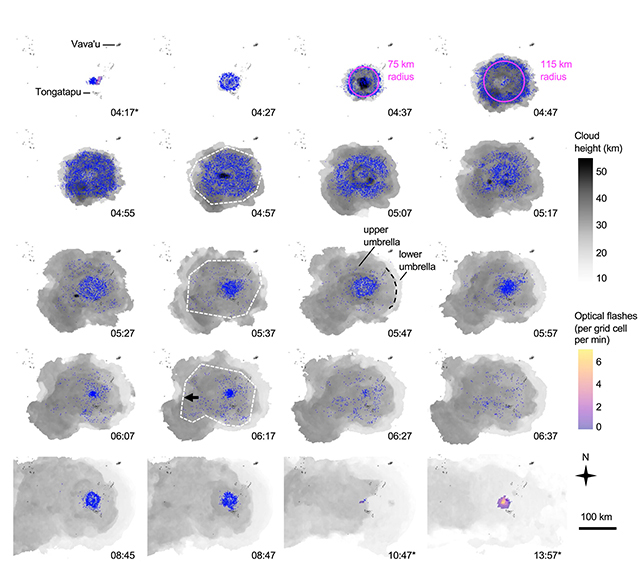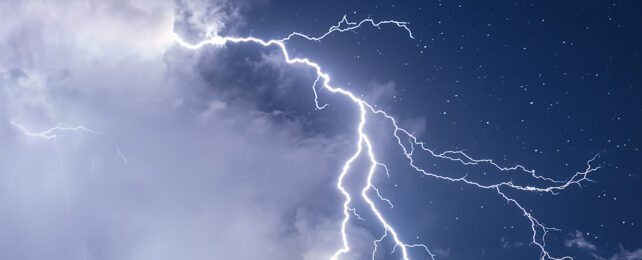Blasting debris clear into the stratosphere, the eruption of Tonga's Hunga Volcano in January, 2022, shattered records for its explosive power.
A study by researchers across the US has uncovered more shocking firsts for the event, estimating an astonishing 192,000 flashes of lightning rippling through its tumultuous plume of ash and water vapor in just 11 hours.
Those flashes peaked at a rate of 2,615 per minute, the researchers revealed, making it officially the most intense lightning storm on record. It also produced the highest lightning flashes ever seen, 20 to 30 kilometers (12 to 19 miles) above sea level.
The Hunga Tonga–Hunga Ha'apai eruption, to give it its full title, is officially the largest explosive eruption of the century, creating a plume of ash, water, and gas at least 58 kilometers high.
"This eruption triggered a supercharged thunderstorm, the likes of which we've never seen," says volcanologist Alexa Van Eaton, from the United States Geological Survey (USGS).
"These findings demonstrate a new tool we have to monitor volcanoes at the speed of light and help the USGS's role to inform ash hazard advisories to aircraft."

That "new tool" is actually a combination of optical and radio readings combined together as one complete set of data. The researchers used instruments measuring electromagnetic radiation in both visible and radio frequencies, including satellites in orbit and radio antennas on land that were able to detect pulses of electrical current.

By combining that data, the team could get a real-time simulation of the lightning storm happening above Hunga, despite the vastness and thickness of the plume billowing out. The observations showed the eruption lasted longer than previously thought, containing almost half a billion electric pulses.
We know that part of the reason the eruption was so gigantic was because it started underwater, with magma vaporizing seawater as it burst directly into it. It seems the conditions were perfect for a supercharged lightning storm too, as volcanic ash, supercooled water, and hailstones collided.
The research revealed more about the eruption and its plume too. The lightning tended to 'surf' on giant waves generated by the eruption in the southern Pacific Ocean, with high-altitude turbulence sending out ripples of material. These waves formed rings that were up to 250 kilometers wide.
"The scale of these lightning rings blew our minds," says Van Eaton. "We've never seen anything like that before, there's nothing comparable in meteorological storms."
"Single lightning rings have been observed, but not multiples, and they're tiny by comparison."
In short, massive eruptions like this can generate their own weather systems, systems that can have an intensity above and beyond what occurs through the standard meteorological patterns we see from day to day.
The lightning data also revealed four distinct phases in the eruption, which hadn't been previously spotted. That will help future eruption forecasting and modeling, helping keep people safe and to predict threats to life should such a blast happen again.
This type of eruption style does have a name: phreatoplinian (magma into water). However, it's never been seen before in actual data – before now, we only had geological records to tell us that these kinds of eruptions were possible.
"It was like unearthing a dinosaur and seeing it walk around on four legs," says Van Eaton. "Sort of takes your breath away."
The research has been published in Geophysical Research Letters.
